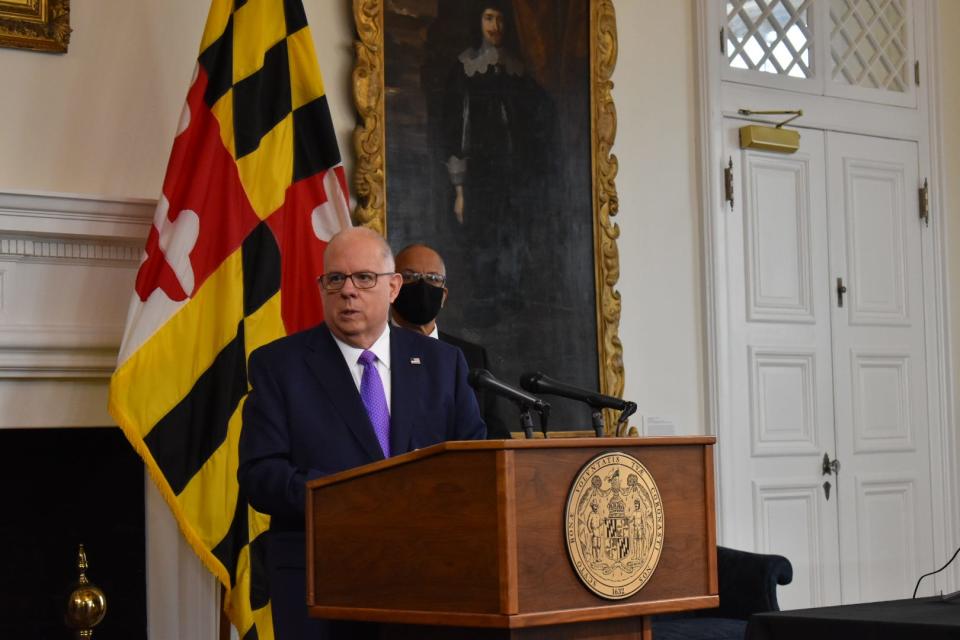Maryland's COVID-19 state of emergency to end July 1
Maryland's COVID-19 state of emergency will end on July 1, more than 15 months after the deadly virus made its first appearance here in March 2020.
All remaining health restrictions will end on that date, Gov. Larry Hogan said Tuesday, including mask mandates.
"The battle's not over," Hogan said. "We're transitioning from a state of emergency to an ongoing operation."

That operation will include continuing to vaccinate thousands of Marylanders who still need the shots and caring for the shrinking number of people sickened by the virus.
Over the course of the pandemic, Maryland has seen more than 460,000 cases of COVID-19. Nearly 9,500 people died, many of them elderly and vulnerable.
Hogan said Tuesday that Maryland's health metrics have improved significantly since the worst peak of the pandemic in the winter.
"We have finally reached the light at the end of the tunnel," Hogan said.
There will be a 45-day grace period after July 1 to allow Marylanders to adjust to the end of emergency regulations, Hogan said. That includes an extra 45 days to renew driver's licenses and an extension to the state's eviction moratorium.
Ending the state of emergency does not affect Maryland's access to federal funds, Hogan said.
It was not immediately clear whether local jurisdictions will continue to have their own authority to enforce restrictions after the state's emergency declaration expires. Hogan said some jurisdictions may have that power, while others may not.
Businesses will be allowed to continue requiring masks and the state will support them, Hogan said. There will no longer be any legal requirement at the state level to wear face coverings.
Maryland will also use parts of the new health infrastructure to distribute COVID-19 booster shots as needed and to ramp up a flu vaccine campaign in the fall. Health officials expect the flu to return with a vengeance after COVID-19 health precautions largely blocked the influenza virus from spreading last year.
Dr. Jinlene Chan, Maryland's deputy secretary for public health services, said residents who haven't yet been vaccinated against COVID-19 should get the shot in order to prevent serious illness.
"Even though our hospitalization rates are low, ... people who are getting sick and certainly the sickest are those primarily who remain unvaccinated," she said.
But the state will not mandate vaccines, Hogan said, even as the rate of vaccination slows. More than 72% of Maryland adults have received at least one dose of the COVID-19 vaccine, and about 3 million people are fully vaccinated.
The number of new vaccinations has fallen off as health officials work to reach less accessible populations.
More: Maryland hits COVID-19 goal of 70% partially vaccinated
Vaccination rates have also remained stubbornly low in rural parts of the state. In Washington County, just 36% of residents have received their first vaccine dose.
Only 34% of residents have received a dose in Somerset County. In Wicomico County, 38% of residents have gotten at least one dose.
The vaccination campaign has succeeded in pushing Maryland's health metrics to new lows.
As of Tuesday, the state's positivity rate is 0.82%. Hospitalizations have dropped to some of the lowest rates of the pandemic.
Maryland reported just 67 new cases of COVID-19 Tuesday.
"There were days when I wasn’t sure we’d ever get here," Hogan said.
Madeleine O'Neill covers the Maryland State House and state issues for the USA Today Network. She can be reached at moneill@gannett.com or on Twitter at @maddioneill
This article originally appeared on Salisbury Daily Times: Gov. Hogan announces end of Md. COVID-19 state of emergency

 Yahoo Movies
Yahoo Movies 
